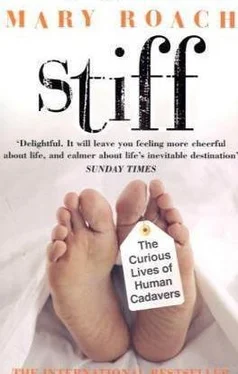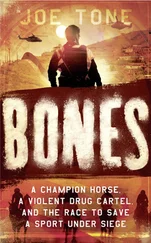There have been times this morning when I wished that someone had outfitted me with a pair of eye caps. I’ve been standing around, eyelids up, in the basement embalming room of the San Francisco College of Mortuary Science.
Upstairs is a working mortuary, and above it are the classrooms and offices of the college, one of the nation’s oldest and best-respected. [9] And, alas, most expensive and least well attended. In May 2002, a year after I visited, it closed its doors.
In exchange for a price break in the cost of embalming and other mortuary services, customers agree to let students practice on their loved ones. Like getting a $5 haircut at the Vidal Sassoon Academy, sort of, sort of not.
I had called the college to get answers about embalming: How long does it preserve corpses, and in what form? Is it possible to never decompose?
How does it work? They agreed to answer my questions, and then they asked me one. Did I want to come down and see how it’s done? I did, sort of, sort of not.
Presiding at the embalming table today are final-semester students Theo Martinez and Nicole D’Ambrogio. Theo, a dark-haired man of thirty-nine with a long, distinguished face and narrow build, turned to mortuary science after a string of jobs in credit unions and travel agencies. He says he liked the fact that mortuary jobs often include housing. (Before cell phones and pagers, most funeral homes were built with apartments, so that someone was always there should a call come in at night.) For the beautiful and glossy-haired Nicole, episodes of Quincy sparked an interest in the career, which is a little puzzling, because Quincy, if I recall, was a pathologist. (No matter what they say, the answer never quite satisfies.) The pair are garbed in plastic and latex, as am I and anyone else who plans to enter the “splash area.” They are working with blood; the garments are a precaution against it and all it may bring on: HIV, hepatitis, stains on your shirt.
The object of their attentions at the moment is a seventy-five-year-old man, or a three-week-old cadaver, however you prefer to think of it. The man had donated his body to science, but, owing to its having been autopsied, science politely declined. An anatomy lab is as choosy as a pedigreed woman seeking love: You can’t be too fat or too tall or have any communicable diseases. Following a three-week sojourn in a university refrigerator, the cadaver wound up here. I have agreed to disguise any identifying features, though I suspect that the dehydrating air of refrigeration has gotten a jump on the task. He looks gaunt and desiccated. Something of the old parsnip about him.
Before the embalming begins, the exterior of the corpse is cleaned and groomed, as it would be were this man to be displayed in an open casket or presented to the family for a private viewing. (In reality, when the students are through, no one but the cremation furnace attendant will see him.) Nicole swabs the mouth and eyes with disinfectant, then rinses both with a jet of water. Though I know the man to be dead, I expect to see him flinch when the cotton swab hits his eye, to cough and sputter when the water hits the back of his throat. His stillness, his deadness, is surreal.
The students move purposefully. Nicole is looking in the man’s mouth.
Her hand rests sweetly on his chest. Concerned, she calls Theo over to look. They talk quietly and then he turns to me. “There’s material sitting in the mouth,” he says.
I nod, picturing corduroy, swatches of gingham. “Material?”
“Purge,” offers Nicole. It’s not helping.
Hugh “Mack” McMonigle, an instructor at the college, who is supervising this morning’s session, steps up beside me. “What happened is that whatever was in the stomach found its way into the mouth.” Gases created by bacterial decay build up and put pressure on the stomach, squeezing its contents back up the esophagus and into the mouth. The situation appears not to bother Theo and Nicole, though purge is a relatively infrequent visitor to the embalming room.
Theo explains that he is going to use an aspirator. As if to distract me from what I am seeing, he keeps up a friendly patter. “The Spanish for ‘vacuum’ is aspiradora .”
Before switching on the aspirator, Theo takes a cloth to the man’s chin and wipes away a substance that looks but surely doesn’t taste like chocolate syrup. I ask him how he copes with the unpleasantnesses of dealing with dead strangers’ bodies and secretions. Like Arpad Vass, he says that he tries to focus on the positives. “If there are parasites or the person has dirty teeth or they didn’t wipe their nose before they died, you’re improving the situation, making them more presentable.”
Theo is single. I ask him whether studying to be a mortician has been having a deleterious effect on his love life. He straightens up and looks at me. “I’m short, I’m thin, I’m not rich. I would say my career choice is in fourth place in limiting my effectiveness as a single adult.” (It’s possible that it helped. Within a year, he would be married.)
Next Theo coats the face with what I assume to be some sort of disinfecting lotion, which looks a lot like shaving cream. The reason that it looks a lot like shaving cream, it turns out, is that it is. Theo slides a new blade into a razor. “When you shave a decedent, it’s really different.”
“I bet.”
“The skin isn’t able to heal, so you have to be really careful about nicks.
One shave per razor, and then you throw it away.” I wonder whether the man, in his dying days, ever stood before a mirror, razor in hand, wondering if it might be his last shave, unaware of the actual last shave that fate had arranged for him.
“Now we’re going to set the features,” says Theo. He lifts one of the man’s eyelids and packs tufts of cotton underneath to fill out the lid the way the man’s eyeballs once did. Oddly, the culture I associate most closely with cotton, the Egyptians, did not use their famous Egyptian cotton for plumping out withered eyes. The ancient Egyptians put pearl onions in there. Onions . Speaking for myself, if I had to have a small round martini garnish inserted under my eyelids, I would go with olives.
On top of the cotton go a pair of eye caps. “People would find it disturbing to find the eyes open,” explains Theo, and then he slides down the lids. In the corner of my viewing screen, my brain displays a special pull-out graphic, an animated close-up of the little spurs in action. Madre de dio! Aspiradora! Come the day, you won’t be seeing me in an open casket.
As a feature of the common man’s funeral, the open casket is a relatively recent development: around 150 years. According to Mack, it serves several purposes, aside from providing what undertakers call “the memory picture.” It reassures the family that, one, their loved one is unequivocally dead and not about to be buried alive, and, two, that the body in the casket is indeed their loved one, and not the stiff from the container beside his. I read in The Principles and Practice of Embalming that it came into vogue as a way for embalmers to show off their skills. Mack disagrees, noting that long before embalming became commonplace, corpses on ice inside their caskets were displayed at funerals. (I am inclined to believe Mack, this being a book that includes the passage “Many of the body tissues also possess some measure of immortality if they can be kept under proper conditions…. Theoretically, it is possible in this way to grow a chicken heart to the size of the world.”)
“Did you already go in the nose?” Nicole is holding aloft tiny chrome scissors. Theo says no. She goes in, first to trim the hair, then with the disinfectant. “It gives the decedent some dignity,” she says, plunging wadded cotton into and out of his left nostril.
Читать дальше












